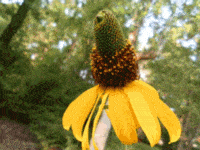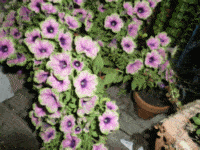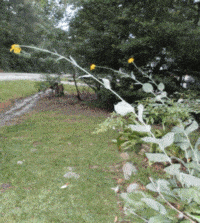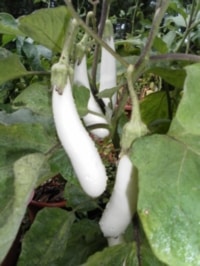
Hurricane Season Again
Hurricane season is here again. We should examine the overall condition of our trees. Trees that have large dead branches or whole trees that are dead should be dealt with as soon as possible. Dead branches should be pruned off, and dead trees should be removed. Trees that are one-sided or leaning significantly may need attention. Selective pruning can relieve the weight on the heavier side, balancing out the weight distribution of the canopy. After the prolonged rain associated with hurricanes, the soil may be so soft that trees topple over if the weight is not proportioned properly. Selective thinning of the canopy can reduce the wind resistance of the tree. This can reduce the chances of it being blown over or of branches breaking. The idea is to preserve the natural shape of the tree but to thin out branches to reduce the weight and allow for better wind movement through the tree. This should be done by a licensed arborist. Look for branches that hang over the house near the roof. High winds of hurricanes and summer storms can cause trees to bend and branches to flail around considerably. These branches can cause extensive damage to a roof and should be removed.

Dry Season in the Garden
To protect our investments and beloved gardens, we have to be prepared to water our gardens. It is not always in our best interest to water by hand. We simply cannot water as well as Mother Nature. Use a sprinkler. The cheap ones work just fine. Most plants will do well with 1 inch of water per week. Put out a tin can or bowl, mark it at 1 inch from the bottom with a marker and sit the can directly in the garden area being watered. Watch the time and stop watering that area once the can is filled to 1 inch. Now, you know how long to water your garden or lawn. Using a soaker hose is an efficient way to water with less evaporation of water. Simple snake the soaker hose throughout the selected garden bed making sure all plants come into contact with the hose. Bury the soaker hose with mulch and attach to water hose. Potted plants may need to be watered daily or twice daily. Water deeply for best root growth, once watered, the water should drip from the bottom of the pot. Read your plant label recommendations or stick your finger in the soil to test for dryness.
Tips for June
Prune azaleas no later than mid-July. Pruning azaleas after midsummer may remove next season’s developing flower buds. This applies to most spring-flowering shrubs as well as hydrangeas and gardenias. Encore azaleas are an exception. They should be pruned immediately after they finish the spring blooming period.
Cut faded flowers from flowering annuals and perennials to encourage new growth and flowers. Old blooms and seed heads left on the plants can retard continued flower production.
Roses generally do not grow as well, bloom as well or look as attractive during the intense heat of mid- to late summer. Many gardeners interpret the lower vigor and poor quality flowers to mean the roses need more fertilizer. Heat is the issue, however, and roses actually need less fertilizer in late June, July and early August. Use only moderate fertilization, if you do any at all. The next best time to fertilize roses will be in late August when they are pruned.
Louisiana irises are semi-dormant during late summer. Prune off seedpods and yellow or brown foliage to help keep the plants more attractive.

Hydrangea Flower Color
The common big-leaf or mop-head hydrangea is known for its flower colors, which can be changed from pink to blue or blue to pink by adjusting soil acidity (pH).
The color variation is caused by the presence or absence of aluminum compounds in the flowers. If aluminum is present in the plant, the flower color will be blue. If present in small quantities, the color will be in between (violet), and if aluminum is absent, the flower color will be pink.
Soil pH indirectly affects flower color by affecting the availability of aluminum in the soil. When the pH is acid (pH 5.5 or lower), aluminum generally is more available to the roots. When the soil pH is neutral to alkaline (7.0 or higher), aluminum levels are decreased.
To gradually change flower color of hydrangeas from pink to blue, broadcast 1/2 cup of sulfur per 10 square feet of bed area under the hydrangeas and water it into the soil. To make pink flowers, broadcast 1 cup of dolomitic lime per 10 square feet of bed area and water it into the soil. Granular products can be applied anytime during the year. It takes patience to change hydrangea flower color, however. It may be a year before you begin noticing a color change.
A quicker way to force flower color change is through liquid soil drenches applied in March, April and May. To make flowers bluer, dissolve 1 tablespoon of aluminum sulfate in 1 gallon of water. To make flowers pinker, dissolve 1 tablespoon of hydrated lime in 1 gallon of water. Drench the soil around the plant with the solution. Avoid getting the aluminum sulfate or hydrated lime solution on the plant’s foliage.

Giant Coneflower
Rudbeckia maxima is a hardy perennial native to the pine forests with dry soils of western Louisiana, Texas, Arkansas and Mississippi. The lower foliage is a dense rosette until it elongates during flowering into stiff erect stems. It is propagated by seeds and division of clumps. Flowers are showy daiseylike heads, 3 to 4 inches across on stems 3 feet or more. Brown, elongated-center tubular flowers encircled with yellow ray flowers. These giant cone flower plants grow to six feet with tall yellow flowers appearing above the foliage. Use in the back of beds and borders; as a specimen plant or planted in groups. They enjoy full sun and well drained soil but responds to wet fertile soils. Blooms June to July.
Summer Lawn Care
Watch for chinch bugs in St. Augustine and Bermuda grass lawns and treat with an LSU AgCenter recommended insecticide. Chinch bug problems show up as yellow-brown areas of the lawn during hot and dry weather. These insects extract plant juices from turfgrass stems and crowns while pumping toxic salivary fluids into the plant. The fluids disrupt the plant’s vascular system. Check for chinch bugs in the lawn by saturating suspected areas with a gallon of water mixed with a few squirts of lemon dishwashing soap. This soapy solution irritates chinch bugs and brings them up near the grass surface so you can determine if the bugs are causing the lawn damage. Additional insect problems that appear during the summer include armyworms and tropical sod webworms. These moth larvae or “worms” can cause severe lawn damage very quickly and will need to be killed with insecticides to prevent further damage. Be mindful of these pests as you walk through your lawns. Investigate damaged areas and treat accordingly.
Don’t overwater you lawn. Water deeply only once or twice per week – or as needed, based on the amount of rainfall. Centipede grass is the least tolerant lawn to drought, so take care to provide adequate amounts of moisture for this grass, especially during dry periods.
Fertilize St. Augustine, Bermuda and zoysia grasses in June and again in early to mid-August with at least 1 pound of actual nitrogen per 1,000 square feet. For example, you would apply 7 pounds of 13-13-13 per 1,000 square feet or 5 pounds of 19-19-19 per 1,000 square feet.
Hot Season Vegetables and Herbs
During the month of June, continue to plant the same plants you started from the May newsletter. Transplant heat-set tomatoes, they will continue to produce fruit from August through October. These tomato cultivars have been bred to set fruit during high nighttime temperatures, whereas other cultivars will not. Examples of heat-set tomatoes include Florida 91, Solar Set and Sun Master, plus there are many others. Heat-set tomatoes can be planted again in late July for fall tomato production.

Collards, cucumbers, melons, cantaloupes, okra, southern peas, pumpkins and summer squash are good to plant during this month. Also plant cucuzzi,
Luffa, Malabar spinach, mirliton, New Zealand spinach, peanut, soybeans, basil, perilla, sesame, mint, oregano, lemon balm, lemon verbena, mountain mint, Mexican oregano, garlic chives, rosemary , bergamont, hyssop, Mexican tarragon, yarrow, burnet & rue. Transplant eggplants, peppers (bell and hot) and sweet potato slips. Start seed of fall tomatoes and bell peppers. Good pest control practices are a must because of the high pressure of insects, diseases and our present drought situation.
Squash and cucumbers can be planted in June, July and August. Summer plantings normally will be ready to begin harvesting after about six weeks. Yields usually are lower than spring plantings. A fall crop of yellow summer squash, zucchini and cucumbers can be grown by planting seed during August. Squash vine borers may be a more severe problem during fall than spring, so be prepared to control them with an insecticide. Viruses are a problem during the fall. New cucumbers are Daytona and Stonewall. New squash are Medallion, Fortune, Lioness, Justice, Lynx and Leopard.
submitted by Karen Blackburn
